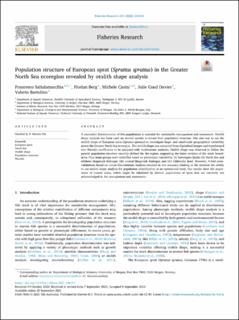| dc.contributor.author | Saltalamacchia, Francesco | |
| dc.contributor.author | Berg, Florian | |
| dc.contributor.author | Casini, Michele | |
| dc.contributor.author | Davies, Julie Olivia | |
| dc.contributor.author | Bartolino, Valerio | |
| dc.date.accessioned | 2021-11-19T07:43:25Z | |
| dc.date.available | 2021-11-19T07:43:25Z | |
| dc.date.created | 2021-11-17T12:44:26Z | |
| dc.date.issued | 2022 | |
| dc.identifier.issn | 0165-7836 | |
| dc.identifier.uri | https://hdl.handle.net/11250/2830385 | |
| dc.description.abstract | A successful discrimination of fish populations is essential for sustainable management and assessment. Otolith shape analysis has been used on several species to reveal their population structure. Our aim was to use the otolith shape of European sprat (Sprattus sprattus) to investigate large- and small-scale geographical variability across the Greater North Sea ecoregion. The otolith shape was extracted from digitalised images and transformed into Wavelet coefficients to be analysed with multivariate statistics. Otolith shape was observed to follow the genetic population structure recently defined for the region, supporting the latest revision of the stock boundaries. Four main groups were identified based on phenotypic variability: (i) Norwegian fjords; (ii) North Sea and offshore Skagerrak–Kattegat; (iii) coastal Skagerrak–Kattegat; and (iv) Uddevalla fjord. However, 4-fold cross-validations based on Linear Discriminant Analysis resulted in low accuracy limiting at the moment the ability to use otolith shape analysis for population identification at an operational basis. Our results show the importance of coastal areas, which might be inhabited by distinct populations of sprat that are currently not acknowledged in the management and assessment. | en_US |
| dc.language.iso | eng | en_US |
| dc.publisher | Elsevier | en_US |
| dc.rights | Navngivelse 4.0 Internasjonal | * |
| dc.rights.uri | http://creativecommons.org/licenses/by/4.0/deed.no | * |
| dc.title | Population structure of European sprat (Sprattus sprattus) in the Greater North Sea ecoregion revealed by otolith shape analysis | en_US |
| dc.type | Journal article | en_US |
| dc.type | Peer reviewed | en_US |
| dc.description.version | publishedVersion | en_US |
| dc.rights.holder | Copyright 2021 The Author(s). | en_US |
| dc.source.articlenumber | 106131 | en_US |
| cristin.ispublished | true | |
| cristin.fulltext | postprint | |
| cristin.qualitycode | 1 | |
| dc.identifier.doi | https://doi.org/10.1016/j.fishres.2021.106131 | |
| dc.identifier.cristin | 1955532 | |
| dc.source.journal | Fisheries Research | en_US |
| dc.identifier.citation | Fisheries Research. 2022, 245, 106131. | en_US |
| dc.source.volume | 245 | en_US |

